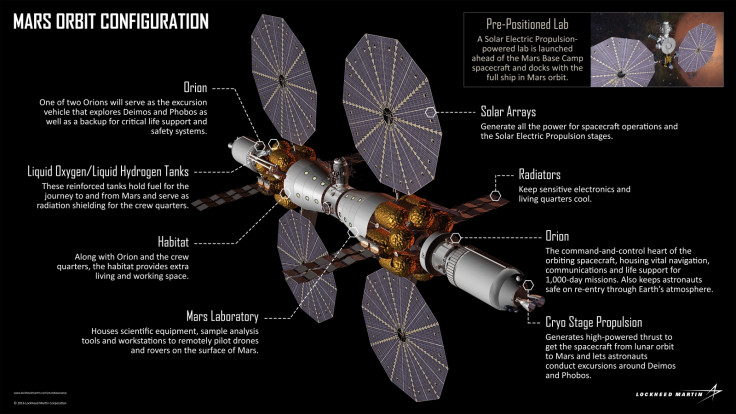Lockheed Martin building an orbiting Mars base to send humans to Red Planet by 2028
US aerospace and defence firm Lockheed Martin has unveiled a concept for a new Mars base that will orbit the Red Planet instead of being based on the planet's surface, enabling humans to be sent to Mars by 2028.

Unveiled at the Human to Mars space conference in Washington DC on Wednesday 18 May, the Mars Base Camp is a space station designed to orbit around the Red Planet, similar to the International Space Station (ISS), only smaller.
The base camp will include a habitat with crew quarters as well as living and working space, two Orion crew capsules containing the spacecraft's command and control centre, as well as a laboratory for six astronauts.
Also included in the design are radiators to keep sensitive electronics and living quarters cool, solar arrays to harness power from the sun for spacecraft operations and propulsion, and a cryogenic rocket engine that produces a high-powered thrust to get the spacecraft from lunar orbit into deep space to Mars and enables the astronauts to go on excursions around the Red Planet's moons; Phobos and Deimos.
Getting into Mars orbit might be easier than landing
"All of these pieces exist today, they're not brand new," Lockheed Martin's chief technologist for civil space exploration and former NASA astronaut Tony Antonelli told Popular Science. "We're taking advantage of what we've already got."
So unlike the ISS where astronauts currently have to be sent up into orbit via the Soyuz space capsules, essentially the Mars Base Camp will be a heavy lift launch vehicle that can launch a large payload into space, and once it is orbiting the Moon, the spacecraft can then travel to Mars, which is much further away.
"We think that orbiting Mars is a necessary precursor to landing humans on the surface," said Antonelli. "NASA has that in their plans, and we're colouring in the details."
The idea is for the Mars Base Camp to be in Mars orbit for 10-11 months so astronauts can remotely explore Photos and Deimos by operating rovers and drones in real-time. At the moment it takes 20 minutes for signals on Mars to be sent back to Earth, so scientists have to factor in the time delay and plot the rover's course without being able to see in real-time what the rover can see.
Much can be learnt from Mars orbit

By being in orbit of the Red Planet, scientists can learn a lot more about Mars even without landing, and it means that we could learn more instead of spending more time creating and constructing the right habitats.
Lockheed Martin is currently working with Nasa to develop the Orion crew capsule, and Nasa is also separately working on the heavy lift rocket, but Nasa's plans are still not clear about what happens after the rocket gets to lunar orbit. So Lockheed Martin has come up with a proposal it hopes the space agency will consider in order to cement plans to get humans to Mars.
To that end, it has drawn up set targets – have the rocket and capsule ready to launch on an unmanned mission by 2018, and if that is successful, take astronauts to deep space, just beyond the moon in 2023 for the first time ever, and then work their way towards orbiting Mars by 2028.
"We think that putting scientists with laboratories right there in Mars orbit will allow them, in just a few months, to accomplish more science than we've been able to accomplish in the past 40 years," said Antonelli.
© Copyright IBTimes 2024. All rights reserved.






